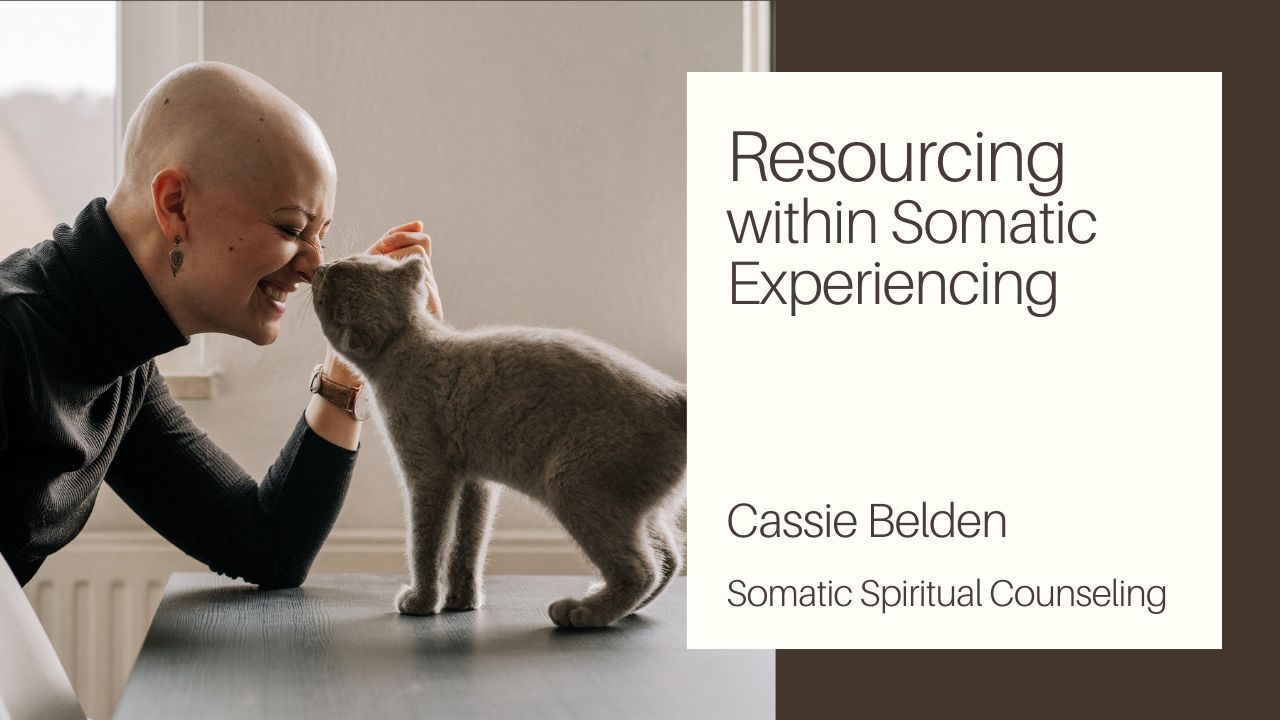If I were to boil down somatic work into just one simple and effective practice, this would be the one! This video walks you through an explanation and experiential exploration of the #1 somatic practice I do.
VIDEO TRANSCRIPT
Hi. This is Dara from Somatic Spiritual Counseling, and today’s video is on a really fundamental principle that I use when working with people, and helping to build resiliency and release trauma from the nervous system.
Gentle Guidance Towards Change
So, first, I want to take you through the explanation as to why this is so important and why it’s so effective, and then we’ll do a little practice together. So, if you’ve ever been around a baby (and I’m assuming most of you have, as we’re all people, and some of us are younger children), you’ll know that it’s a lot more effective if you redirect a child’s attention to something new if they’re screaming or crying or upset, instead of telling them what they’re doing is bad, or to stop doing what they’re doing. So, when you’re with a child and they’re upset, instead of saying “Stop it. Stop doing this thing that I don’t like,” you just move their attention and say, “Hey, look. Look outside the window. Is that a bird?” And you can help guide them towards something to refocus on and reorient.
And our nervous system is much the same way. As adults, we don’t really realize we’re doing this, but when we focus on what’s wrong all the time, we’re basically sending the signal to our nervous system: “We want to keep focusing on what’s wrong. Show me what’s wrong.” And so, we do this conversationally, especially if somebody comes through my office door and they’re saying, “This thing. I feel this pain. I have this problem with my partner. This and this.” And yeah, those are all valid. The problem is it can become kind of an addictive cycle. It can become this repetitive loop that you get stuck in, where maybe you have something that’s wrong and you focus on it, and maybe you work through it and you resolve it, you get a high off of the resolution, it feels great to have felt bad and then to feel better, and then you do it again because it’s addictive. So, it’s sending our body the message: You need to feel worse before you feel better.

Does Feeling Better Require Feeling Worse First?
Let’s step into a different paradigm where feeling better actually just means feeling better, and practicing feeling better is how we feel better. It’s a muscle we’re squeezing, and we’re just learning how to feel better. And then maybe we do feel bad, but we’re just practicing feeling better without having to feel bad first. So, what is that like? It’s like redirecting this child’s attention to something that’s pleasurable or engaging or interesting. And what does this look like? Well, it looks like either engaging with the environment around you and finding something that feels supportive, or engaging with your body inside of you and finding something that feels supportive. It doesn’t really matter if you’re looking in or if you’re looking out. Ideally, you’re able to do both fluidly, and your world actually corresponds with your insides.
So, what does this do to the nervous system when we send this message of “I want to feel better, so I’m just going to focus on feeling better”? Well, it creates a positive reinforcement loop. Instead of, before, we had this kind of negative reinforcement loop where we’re saying, “We don’t want this. Stop doing this. We want to do something else,” now we’re saying, “Oh, this. This feels good. I want more of this.” It cottons a lot more quickly. Just like that child is going to stop crying a lot more quickly, our nervous system is going to respond, adapt, and heal a lot more quickly if we use positive reinforcement instead of negative reinforcement with ourselves.
Practicing Together
So, let’s put this into practice right now. We’re going to take a few minutes and practice this, and see what it’s like. And then I’ll talk a little bit about it afterwards. So, I want to invite you now to find a comfortable seat, or whatever posture you’re in. Maybe you’re lying down or standing. And I want you to open up your senses, either internally or externally, or both. So, perhaps that means looking around at your environment, or perhaps that means closing your eyes and looking inside at your internal environment. First, for now, just noticing what you notice in a neutral way, not allowing yourself to get grabbed by something that’s wrong, just giving everything equal attention.
Great. Now that you have a little bit of a sense of where you are, what happens when you allow yourself to gravitate towards something in your experience, in your environment, or in your body that feels supportive? And this doesn’t have to be a really big sensation or a really big external stimulus. It can be subtle. Right now, I’m feeling the breeze on my face, and it feels great, so that’s what I’m focusing on. Maybe there’s some light on the leaves. Once you find something that feels supportive, this is the work right here. I want you to allow yourself to enjoy it a little bit more. That’s it. It’s very simple yet very profound. And what do I mean by let yourself enjoy this a little bit more? I literally mean soak it in. Give yourself permission to receive enjoyment, like taking a slightly deeper breath and seeing what that’s like to do that.
Great. So, what do you notice? What happens to your physiology? What do you notice your mind does when you find something that feels supportive and allow yourself to rest in the enjoyment of that thing? What does your body do? Typically, when I do this with myself or with another person, they find, or I find, as I’m finding now, that my system relaxes, and it’s quick, and it’s pretty painless and effortless. And it’s not because I’ve worked through something and I’m feeling the release of not feeling a burden anymore. It’s just because I’m simply allowing myself to feel good in the present moment. This is our birthright as humans. We have access to this place, this present moment, and to feeling joy.
So, maybe you notice yourself in this place, and stable in this place. Maybe you find yourself being pulled by something else very quickly, and it’s wanting you to come out of this space of openness and clarity. Or maybe you don’t feel a sense of openness and clarity at all. The important thing with this practice is to practice it. And it builds on itself really quickly. Even if you do it for six seconds a day, spread between three different intervals, that is two seconds out of your day, three times a day. That’s a 600% increase to what you were doing before. And that matters because positive reinforcement affects our physiology more quickly than negative reinforcement. And so, even if you start small and do this in really manageable chunks, you’re going to start noticing that your orientation towards your whole life and your whole experience shifts, and you become more resilient and build a foundation of support. So, the point of this is not to bypass what feels bad, but rather, to create a net of support, so that we can more fully feel what feels bad without getting overwhelmed. This basically is increasing our capacity to feel without being overwhelmed. And we’re doing it through feeling pleasant.

Real Change Happens Slowly
There’s another piece to this, which I just want to share, about why working with support and pleasant feelings is more helpful. Not only does it have this positive reinforcement piece, but the way our biology is wired, we kind of find a state of balance or equilibrium, homeostasis, let’s say. And when we’ve adapted to our surroundings, any change to that adaptation can register as a threat. I mean, I can say from my own life, anytime I’m confronted with somebody who wants me to change or be different or thinks that I did something wrong, my immediate ego response is to be defensive, even if I later realize, “Oh, yeah. Okay. I should do something differently. This feels right.” That initial response is like “Oh, no.” And we all do that. It’s very hard not to. And in fact, it has a biological imperative function of why we should do that and continue to do that. It keeps us safe in a way sometimes. But if we get stuck in that, it’s not going to really keep us safe. It’s going to keep us from being able to make positive changes.
So, when we try to make changes based on things we don’t like about ourselves that we want to change, that’s going to register as like a really intense ego threat, right? We’re coming in, and we’re saying like, “Here’s the bar, and this is where you are now, and you need to meet it.” And so, our system has a lot harder of a time adapting and changing, because it basically feels like a threat, even if cognitively we know it’s a good thing to change. So, when we’re working with pleasant sensations, especially when we’re working with really mild pleasant sensations, as we did in this exercise, it doesn’t register as a threat to our nervous system, because it’s just a really slow, gradual incline, and a really slow, gradual decline.
So, instead of trying to push ourselves, we’re just kind of letting ourselves gently ride waves, and over time, it increases in capacity without threatening our sense of self. When somebody says, “You’re doing a really good job doing that thing you’re doing,” usually our ego doesn’t say, “No. This is bad. Why would they say that about me?” It just doesn’t, because we like feeling supported, and we like feeling inspired and appreciated by others. And so, it’s pretty simple. But if you do really apply this principle that I shared with you into your life, it’s not that simple. It’s profound. It will change everything. And I’ve seen this firsthand in my life and in many others. It really has the power to create miracles, healing miracles.
Many Thanks for Watching
So, thank you so much for watching this video and for doing this small practice with me. Like I said, this is a practice that I do pretty much with all of my clients right off the bat. And this is the base. Honestly, if you had to just do one practice for your nervous system, this is the one. This is it. You could just do this and probably make huge shifts. So, if you’re interested in having a more supported container to do this work in, and then to help move the difficult things through, reach out to us. We’re here at somaticspiritualcounseling.com. And my name is Dara del Rio. I work with a bunch of other great practitioners who do similar work, and we’re here to support you. So, be in touch. And thanks again for watching. I’ll see you next time.
Learn more about somatic therapy here.
—————————————————————————————————————————

Dara del Rio | Years ago, Dara’s life was saved by a powerful medicine woman & shaman. The chance encounter altered the course of her life. Dara’s vision asks for a depth of healing that is only possible when mind, body, and spirit are given equal attention and weight. Her approach incorporates somatic awareness and shamanic practices that encourage and facilitate direct communication with the natural world, drawing inspiration from Amazonian, Buddhist, and Taoist healing traditions. She strives to maintain cohesion & clarity in her work with clients, keeping it simple, grounded, balanced, and slow.




